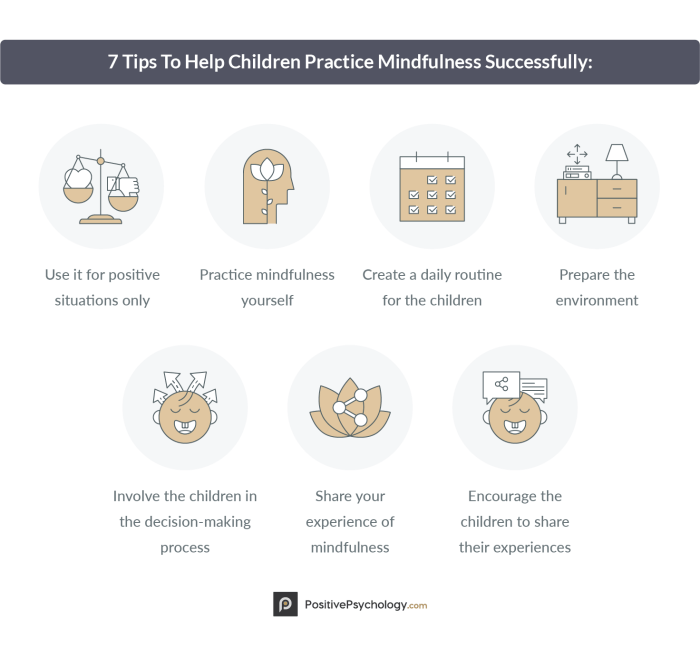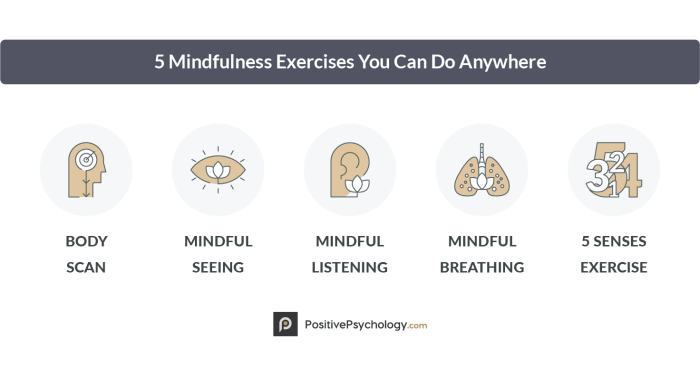Mindfulness Exercises: Get ready to dive into the world of mental well-being and focus with these engaging practices that are sure to elevate your daily routine.
From reducing stress to improving concentration, mindfulness exercises offer a plethora of benefits that can positively impact your emotional balance and overall wellness.
Benefits of Mindfulness Exercises

Mindfulness exercises offer a wide range of mental health benefits that can positively impact our overall well-being. By incorporating mindfulness practices into our daily routine, individuals can experience improvements in focus, concentration, and emotional balance, while also reducing stress and anxiety levels.
Mental Health Benefits, Mindfulness Exercises
- Enhances self-awareness and self-regulation
- Promotes emotional resilience and coping mechanisms
- Reduces symptoms of depression and anxiety disorders
Improved Focus and Concentration
- Helps redirect attention to the present moment
- Enhances cognitive flexibility and problem-solving skills
- Increases productivity and efficiency in daily tasks
Reduced Stress and Anxiety Levels
- Encourages relaxation and stress management techniques
- Improves sleep quality and overall mood
- Reduces the impact of negative thoughts and worries
Overall Well-being and Emotional Balance
- Promotes a sense of calm and inner peace
- Enhances relationships and social interactions
- Fosters a positive outlook on life and increased happiness
Types of Mindfulness Exercises
Practicing mindfulness can take many different forms, each offering unique benefits to the mind and body. By incorporating a variety of mindfulness exercises into your routine, you can deepen your practice and experience a range of positive effects.
Mindful Breathing
Mindful breathing involves focusing your attention on the breath, observing its natural rhythm without trying to change it. This exercise can be done anywhere, anytime, by simply bringing awareness to the sensation of breathing in and out.
Body Scan
During a body scan, you systematically focus on each part of your body, starting from the toes and moving up to the head. By paying attention to physical sensations without judgment, you can release tension and promote relaxation throughout the body.
Loving-Kindness Meditation
Loving-kindness meditation involves directing feelings of love, compassion, and goodwill towards yourself and others. This practice can help cultivate empathy, reduce negative emotions, and foster a sense of connection with the world around you.
By incorporating mindful breathing, body scan, and loving-kindness meditation into your mindfulness routine, you can enhance your overall well-being. Each exercise offers a unique way to cultivate awareness, promote relaxation, and foster positive emotions. Experimenting with different types of mindfulness practices can help you find what works best for you and tailor your routine to suit your needs.
Personally, I have found that combining various mindfulness exercises has been incredibly beneficial for my mental health. Mindful breathing helps me stay grounded in the present moment, while body scans help me release physical tension. Loving-kindness meditation has allowed me to cultivate a sense of compassion and connection with others. Overall, incorporating a mix of mindfulness exercises into my daily routine has helped me manage stress, improve focus, and enhance my overall sense of well-being.
Mindfulness Techniques for Beginners

Practicing mindfulness can be a great way to reduce stress and improve overall well-being. For beginners, starting with simple techniques and creating a conducive environment is key to building a consistent practice.
Start with Breathing Exercises
Breathing exercises are a great way to begin your mindfulness practice. Start by finding a comfortable position, close your eyes, and focus on your breath. Inhale deeply through your nose, hold for a moment, and exhale slowly through your mouth. Repeat this for a few minutes to center yourself and bring awareness to the present moment.
Body Scan Technique
The body scan technique involves paying attention to different parts of your body, starting from your toes and moving up to your head. This practice helps you tune into physical sensations and release tension. Find a quiet space, lie down or sit comfortably, and slowly scan through each body part, noticing any sensations without judgment.
Mindful Walking
Mindful walking is a simple yet effective practice that can be integrated into your daily routine. While walking, focus on the sensation of each step, the movement of your body, and the sounds around you. This practice helps you stay present and engaged with your surroundings.
Creating a Conducive Environment
To create a conducive environment for mindfulness practice, choose a quiet and comfortable space where you won’t be disturbed. Set aside dedicated time each day for your practice and eliminate distractions. You can also enhance the atmosphere with calming music, dim lighting, or the use of essential oils.
Staying Consistent
Consistency is key to reaping the benefits of mindfulness. Start with short sessions, gradually increasing the duration as you become more comfortable. Set reminders or create a daily schedule to help you stay on track. Remember that mindfulness is a skill that takes time to develop, so be patient with yourself and celebrate small victories along the way.
Mindfulness Exercises for Stress Reduction
Mindfulness exercises are powerful tools for reducing stress levels and promoting overall well-being. By cultivating a present-moment awareness and non-judgmental acceptance, individuals can learn to manage stress more effectively and improve their mental health.
Specific Mindfulness Exercises
- Deep Breathing: Focus on your breath, inhaling deeply through your nose and exhaling slowly through your mouth. This helps calm the nervous system and reduce stress levels.
- Body Scan: Close your eyes and bring attention to each part of your body, noticing any tension or discomfort. This practice can help release physical tension and promote relaxation.
- Loving-Kindness Meditation: Send positive thoughts and well-wishes to yourself and others, fostering compassion and empathy which can reduce stress and increase feelings of connection.
Benefits of Mindfulness Practices
Practicing mindfulness can help in managing stress levels by increasing self-awareness, promoting relaxation, and improving emotional regulation. These practices can also enhance resilience and reduce the impact of stress on mental and physical health.
Real-Life Examples
- Amy, a busy professional, started incorporating mindfulness exercises into her daily routine. She found that taking short mindfulness breaks throughout the day helped her stay calm and focused, reducing her stress levels significantly.
- John, a college student, struggled with anxiety and overwhelming stress. After learning and practicing mindfulness techniques, he noticed a significant decrease in his stress levels and an overall improvement in his mood and well-being.
Choosing the Right Mindfulness Exercise
- Identify Your Stress Triggers: Understand what situations or thoughts contribute to your stress, and choose a mindfulness exercise that addresses those specific triggers.
- Experiment and Explore: Try different mindfulness practices to see which ones resonate with you the most. It’s essential to find exercises that you enjoy and find beneficial.
- Consistency is Key: Incorporate mindfulness exercises into your daily routine to experience long-term benefits. Consistent practice can help you build resilience and effectively manage stress over time.